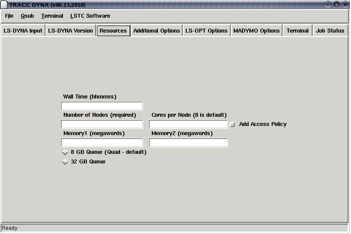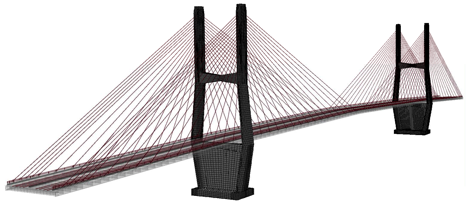Development of GUI for Structural Mechanics Codes
The TRACC Cluster gives its users a lot of flexibility when it comes to requesting software version of LS-DYNA and computational resources for submitted jobs. To fully utilize that flexibility, users need to get familiar with on-line documentation of all the installed releases of different software and modules on the cluster. As on other LINUX based HPC systems, the submission and controlling of LS-DYNA is done through text commands. Especially for new users, memorizing and understanding all the commands and submission process may lead to confusion and multiple errors. To reduce the number of problems and facilitate quick start for new users on the cluster, TRACC staff developed a GUI (Graphical User Interface) called qsub-dyna-gui for submitting LS-DYNA® jobs in a graphical mode. The GUI allows for creating job submission scripts, running and checking the status of the jobs. It also allows for tracking the available resources on the cluster. The use of the GUI is simple and self explanatory for current users of LSTC software. It is based on the "tabs" concept employed, for example, in the LS-OPT® program. The user needs to go through several tabs from left-to-right and specify input parameters in the series of entry fields, checkboxes and dropdown lists. The basic error checking of the input is performed internally within the application. Once all the necessary fields are filled correctly, the application creates a jobscript and submits the job to the cluster. Subsequently the job can be monitored and results can be easily accessed from the last tab of the GUI ' Job status panel (see Figure below).

Graphical User Interface of qsub-dyna-gui
Compute-Efficient model for the Bill Emerson Memorial Bridge

Finite Element model for the Bill Emerson Memorial Bridge
A compute-efficient finite element model for the Bill Emerson Memorial Bridge - a cable-stayed bridge located over the Mississippi River in Cape Girardeau - has been developed. Using Hypermesh, the geometry of the original bridge model was extracted and a new mesh (see Figure above) was created. Key changes involved (1) the use of plate elements in place of hexahedral continuum elements for a substantial portion of the bridge in areas where the mechanics did not require continuum elements; (2) reducing the number of elements from 1,108,659 - of which only 309,079 were deformable - to 248,254; (3) revamping elements with poor aspect ratios; (4) modeling each stay cable as a single cable instead of modeling each strand within each cable; (5) representing the pylons as deformable structural elements, which allows pylon-to-cable interactions to occur; and (6) adding representation for the support bearings between the pylon and the deck structure.
With the above changes, the computational time-step for explicit time integration was dramatically increased from 2.42 µsec to 25.00 µsec, which is over a tenfold increase. This means that a job that would require 24 hours of computational time would now require only about 2 hours - a substantial savings.
The new model will be used to study the effects of wind, traffic and earthquake loadings.
For further information: This email address is being protected from spambots. You need JavaScript enabled to view it.